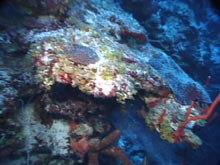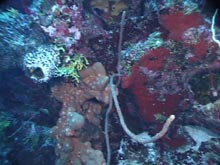Here we can see zonation above 200 feet (60.9 meter) with about 10 to 20% sponge coverage. On top of the overhang, you can still see plating coral that accounts for 10% coverage. Click image for larger view and image credit.
A typical deep sponge community. This image illustrates zonation below 200 ft (60.9 m) with over 60% sponge cover and significant sponge biomass. Click image for larger view and image credit.
Zonation1 on Walls
May 29, 2007
Marc Slattery
University of Mississippi
Michael Lesser
University of New Hampshire
Liz Kintzing
University of New Hampshire
Cristina Diaz
Museo Marino de Margarita – Venezuela
![]() Deep-reef sponges make their shallow-water relatives look very small.
(Quicktime, 1.4 Mb.)
Deep-reef sponges make their shallow-water relatives look very small.
(Quicktime, 1.4 Mb.)
We’re in the zone . . . the Twilight Zone! After 10 days of successively deeper dives, we have finally penetrated the transition between the shallow- and deep-reefs of Little Cayman. The community break was incredibly dramatic as we drifted past an overhang at 190 feet (57.9 meter) to the undercut wall below. Shallow-water species extend to this transition, although their abundance decreases dramatically with depth. Nonetheless, we were unprepared for the rapid change in species assemblages below the overhang; the Twilight Zone seems to be home to one of the most diverse and abundant sponge assemblages in the Caribbean Basin. There appear to be several extremely rare or new species within this community. (From our initial minimal collection, we found 15 sponge species that don’t occur on the shallow-reef.) In addition, these sponges make their shallow-water relatives look minuscule; we saw deep reef species that exceed 12 ft (3.7 m) in diameter!
Zonation1 is an important concept in marine community ecology, but the classic examples are usually associated with the rocky intertidal areas. On the west coast of the United States, the intertidal is characterized by three distinct bands of indicator species. Moreover, the upper distribution of these species is apparently controlled by abiotic2 factors (typically the length of exposure to air during low tides), while the lower depth distribution is determined by biotic3 factors (typically predation by sea stars and competition for space). Coral reefs are also divided into broad zonation schemes based on geomorphology4 and depth, including the back-reef or lagoon, the reef crest, the “spur-and-groove” sections, and the fore-reef walls.
Community complexity has made it difficult to further subdivide these zones by species assemblages. Technical diving has provided us with a mechanism to explore a very different species assemblage representing a true zone on the fore-reef walls of these coral reefs. While our time and depth were limited by safety considerations, we began an initial census of the biodiversity and collected several unique species for further research.
The Twilight Zone may have some characteristics in common with rocky intertidal zones. The upper limit, at 190 ft (57.9 m), is almost certainly controlled by physical factors. The overhang is likely a submerged ancient shoreline from a time when sea levels were much lower than the present, and the undercut may have been formed by past wave actions. The result is a section of the wall that “sees” a dramatic reduction in sunlight, or shading, which quickly selects against the photosynthetic species, like corals and algae. As we noted in a prior blog (May 27), there are almost certainly high nutrient inputs to this deep reef, and the overhang may cause eddies that further constrain nutrients to this region of the reef, thus supporting significant sponge growth rates.
As is the case in any research effort, results tend to generate as many questions as answers. Over the next several months we will examine our data, formulate hypotheses, design experiments, and plan the logistics necessary to further explore and study the Twilight Zone.
2Abiotic refers to components that are non-living chemical and physical factors in the environment.
3Biotic refers to components that are living biological factors in the environment.
4Geomorphology is the study of landforms that include their origin and evolution, and the processes that shape them.





















